The James Webb Space Telescope, known as JWST, was launched by NASA and the European Space Agency on the 25th of December 2021. It is the largest space telescope ever built and is equipped with advanced infrared imaging technologies that can capture high-resolution deep space images.
This behemoth telescope is currently trawling the edge of deep space millions of miles from Earth. For the past year, JWST images have been transmitted back to Earth depicting previously unseen galaxies, nebulae, and space phenomena. In this article, you can see 30 gorgeous James Webb Telescope images up close from some of the most remote parts of the universe.
30 Gorgeous James Webb Telescope Images
Here are 30 of the most amazing images that have been transmitted from the James Webb Space Telescope so far. These images bring some of the most remote parts of space up close so that everyone can learn more about the universe.
1. Nearby Galaxy NGC 7496
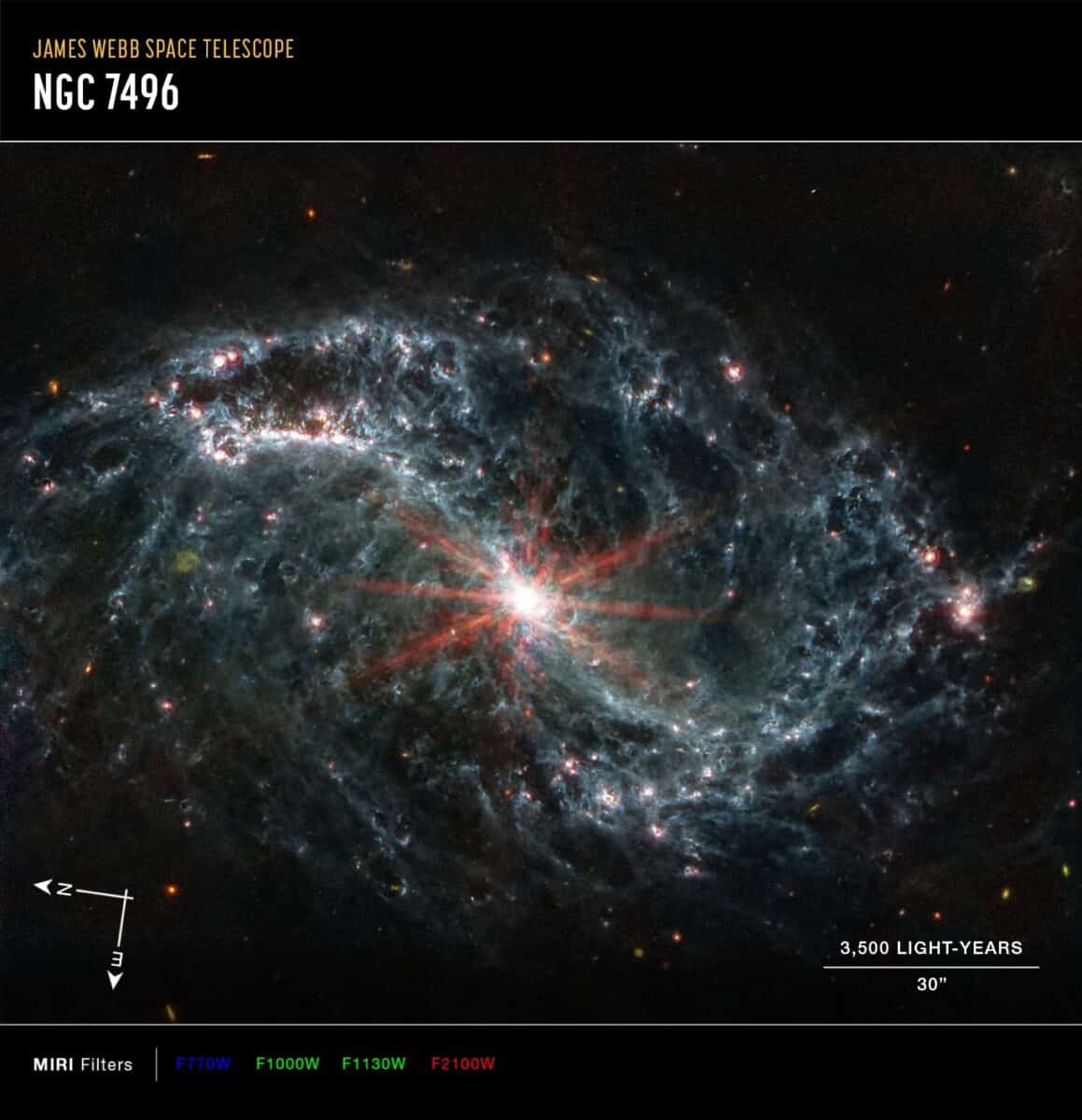
This breathtaking image of a nearby galaxy with trailing spiral arms was taken by the Mid-Infrared Instrument (MIRI) of the James Webb Space Telescope. The bubble-like dark spots in the image are thought to be produced by young stars in the galaxy that are releasing energy.
2. The Chamaeleon I Molecular Cloud
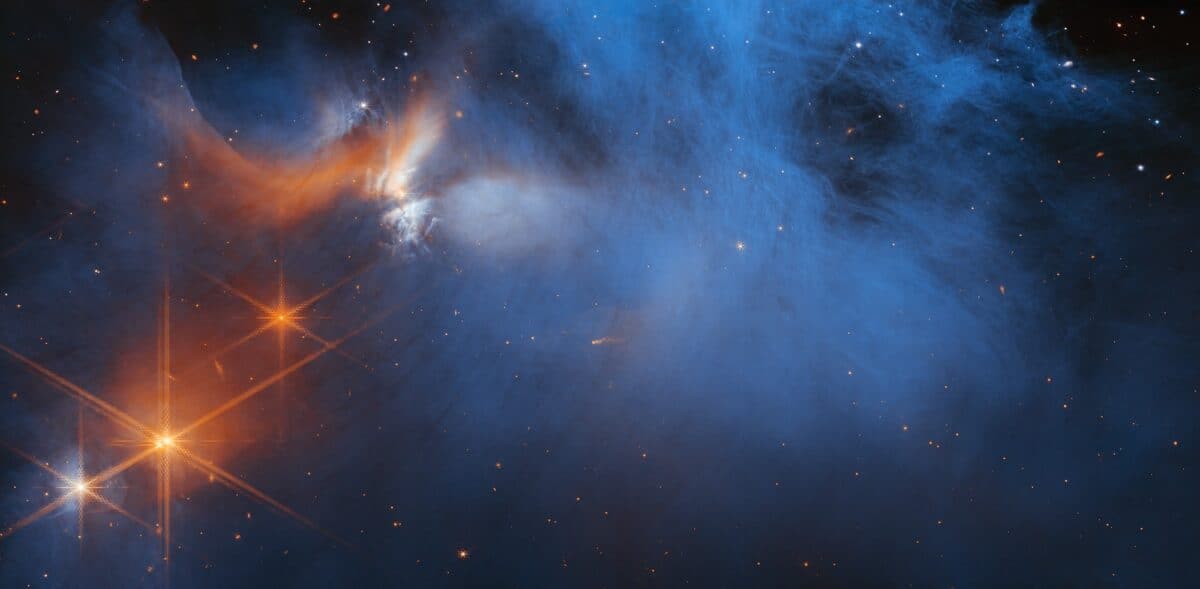
The Chamaeleon is a dark molecular cloud that is formed by high concentrations of space dust which absorb virtually all light emitted by nearby stars, appearing dark. This image of the central region of the Chamaeleon was taken by the Near-Infrared Camera (NIRCam) of the James Webb telescope.
3. Jets of the Carina Nebula
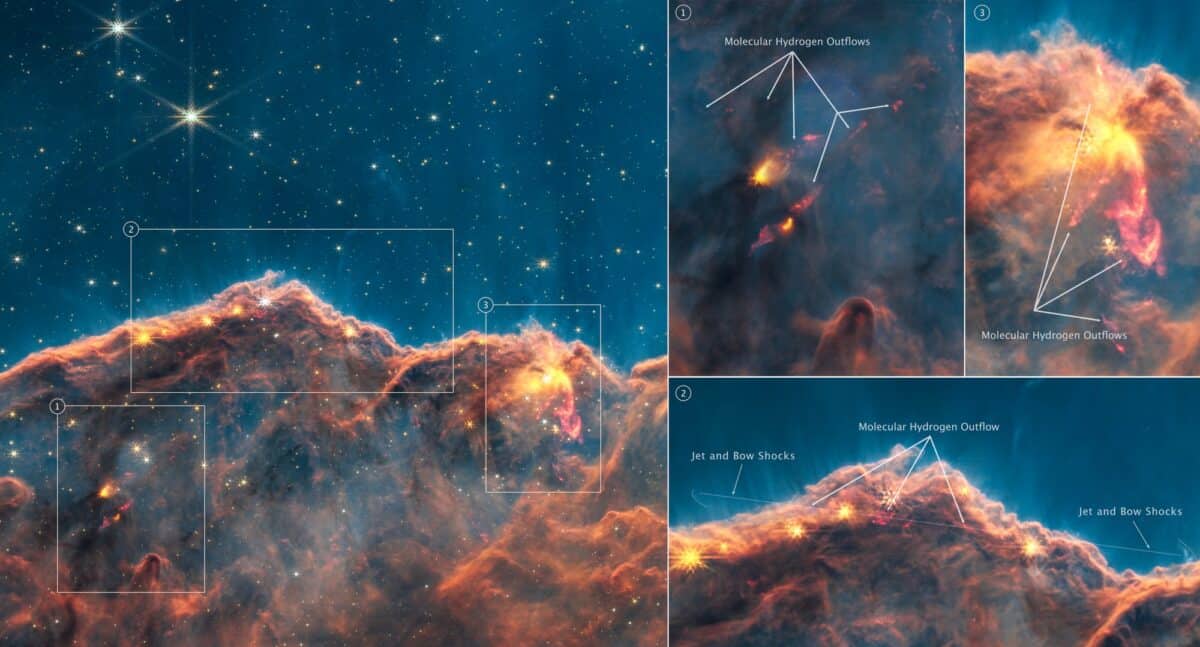
Eta Carina Nebula, known as the Carina Nebula, is an area of nebulosity in the Carina constellation, which can be visibly seen in the southern night sky. This image, captured by the Near-Infrared Camera of the JWST, is of the Cosmic Cliffs, an area where there is massive gaseous activity. Jets of what appears to be steam rising from the cliffs is hot, ionized gas and dust billowing away from the nebula because of acute, ultraviolet radiation. Dozens of these jets and outflows from new stars have only recently been discovered, thanks to this detailed image.
4. Spokes of the Southern Ring Nebula

The Southern Ring Nebula, also known as the Eight Burst Nebula is approximately 0.125 light wide. That is 0.75 trillion miles! This planetary Nebula is part of the constellation Vela. This is an image that has been taken using infrared imaging and recolored using relative visible light colors by NASA scientists.
5. A Protostar Within Dark Cloud L1527
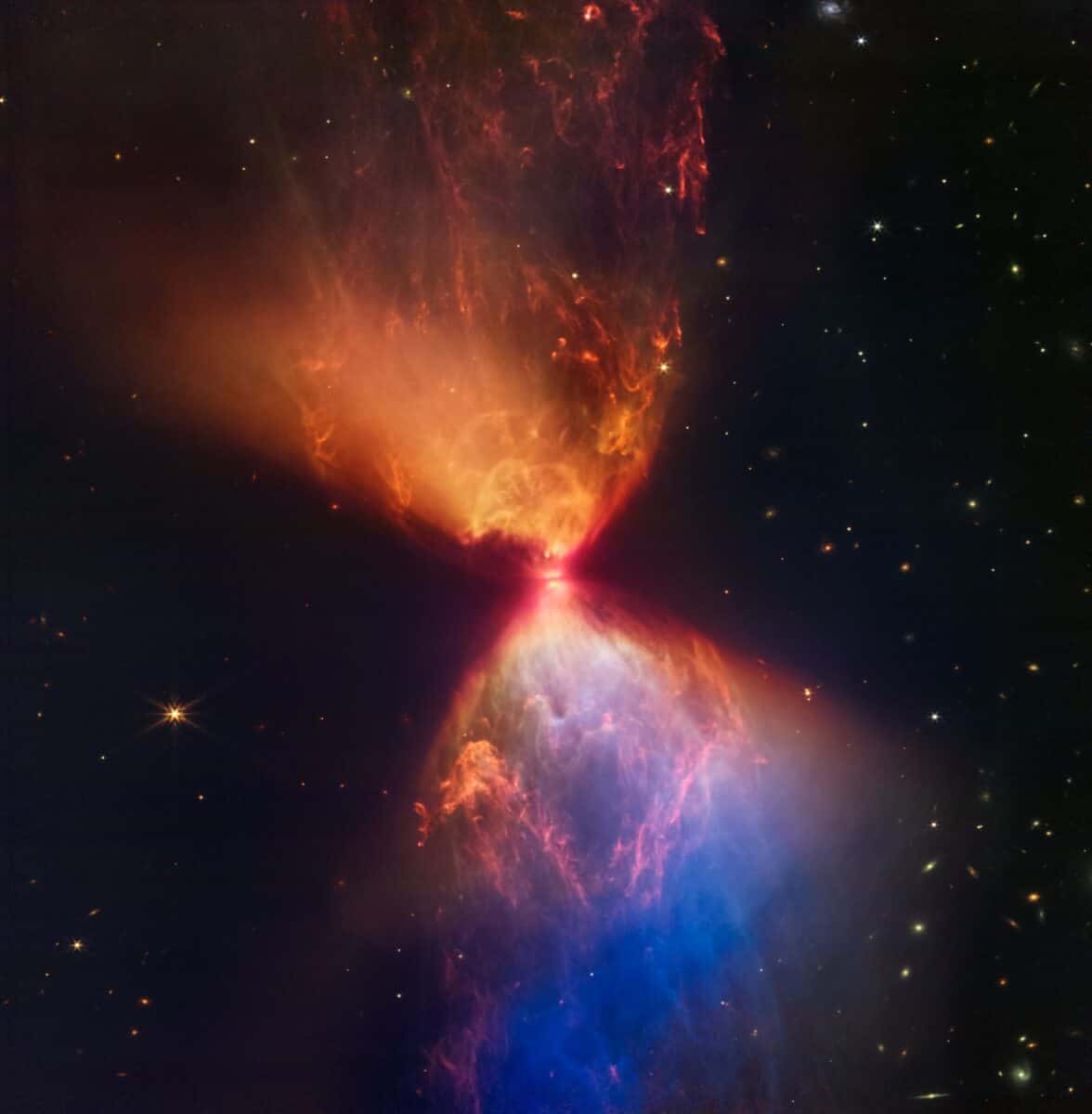
A protostar is an early stage in the formation of a star. It is a contracting mass of gas with extremely high energy potential and ejections from the star are already visible. This protostar sits within a dark cloud of the Taurus constellation. The James Webb Space Telescope’s Near-Infrared Camera (NIRCam) took the image of this young stellar object.
6. Dwarf Galaxy WLM
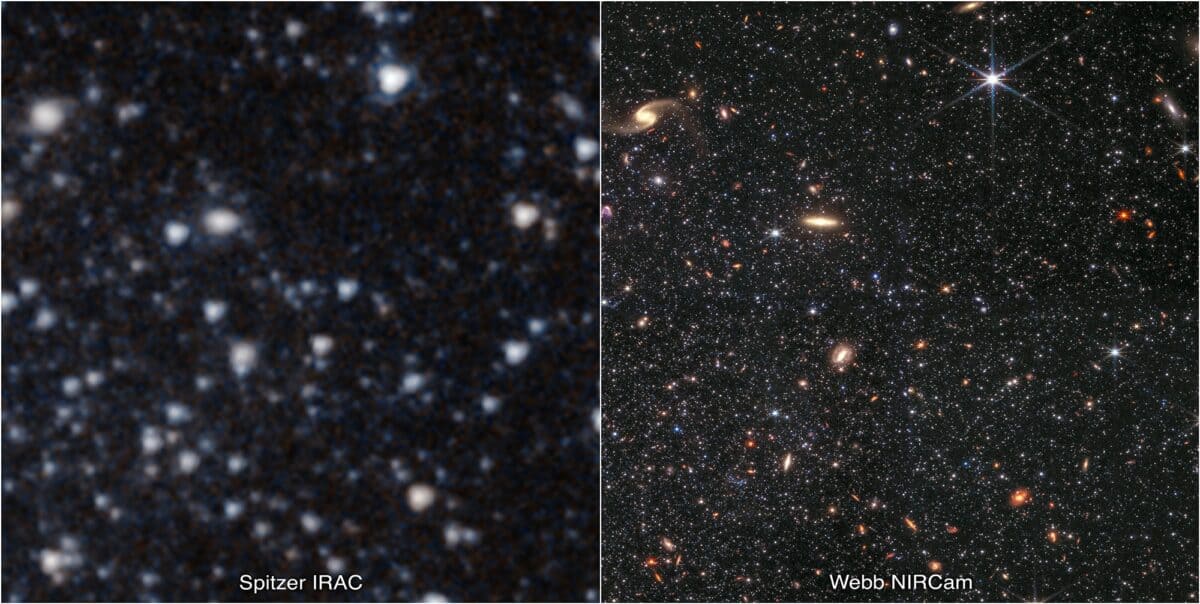
This is an image of the Wolf–Lundmark–Melotte (WLM), a barred, irregular dwarf galaxy that is part of the Cetus constellation. The images were taken by the Spitzer Space Telescope’s Infrared Array Camera and the James Webb Space Telescope’s Near-Infrared Camera. This colorized image captures incredibly distant and faint stars from beyond the Milky Way, a distance of more than 3 million light-years from Earth.
7. Interacting Galaxies

This is a remarkable composite image made from data acquired by the JWST and the Hubble Space telescope. This unique image combines the visible light images from the Hubble Telescope with infrared electromagnetic energy captured by the JWST. The combined images show greater detail of these overlapping spiral galaxies and delineated their dusty spiral arms. When this image was created, other distant galaxies were picked up by the JWST that aren’t visible in the original image.
8. The Cartwheel Galaxy
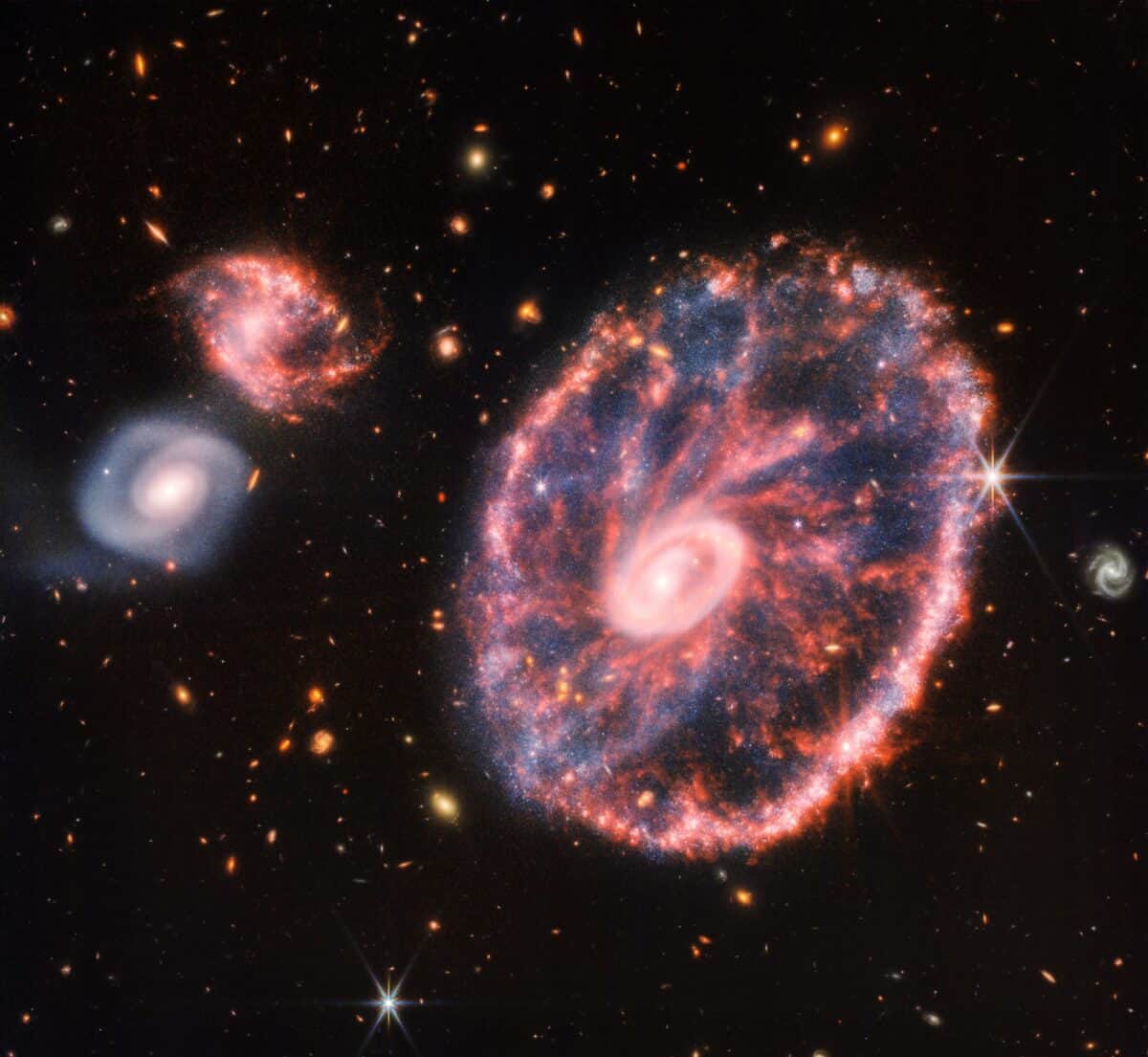
The Cartwheel Galaxy is part of the Sculptor constellation. It is said to have been formed by a high-speed collision that took place more than 400 million years ago. Amazingly this galaxy is still transitioning, so it will not always have this distinctive appearance!
You can see the colorful outer ring and extremely bright inner ring of this galaxy in this colorized image that has been beautifully captured by the Mid-Infrared Instrument (MIRI) and Near-Infrared Camera (NIRCam) of the James Webb Telescope.
9. Dimorphos Ejecta – Hubble and JWST Images Compared
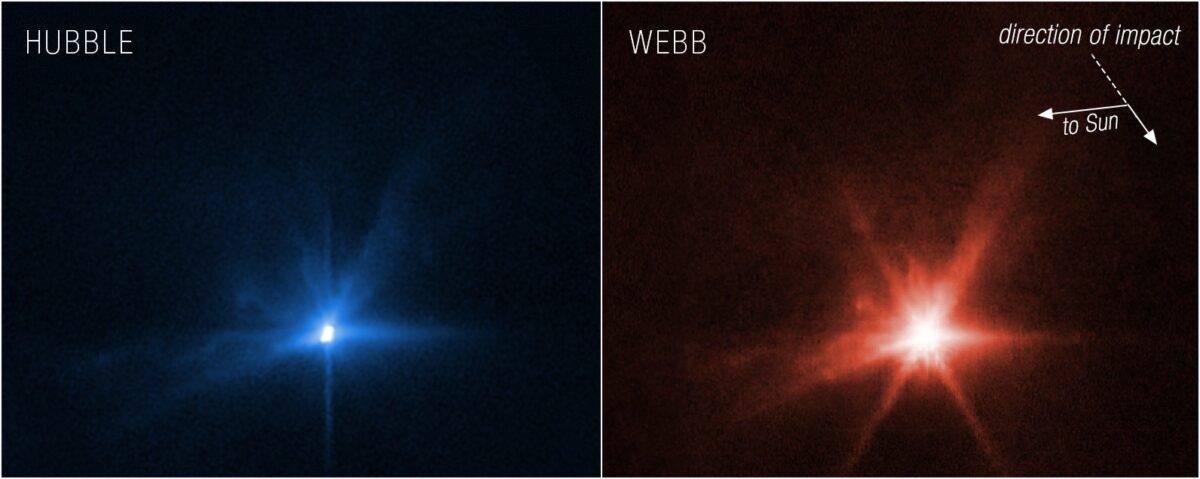
.
This image from September 2022 is important because the JWST and Hubble Space Telescope took images of the Didymos-Dimorphos system at the same time, hours after the Double Asteroid Redirection Test (DART) which had impacted an asteroid, altering its course.
The JWST has proved invaluable in enhancing the resolution of space images like this using infrared imaging. NASA is using data from the telescope to monitor the dust cloud generated by the collision.
10. Neptune
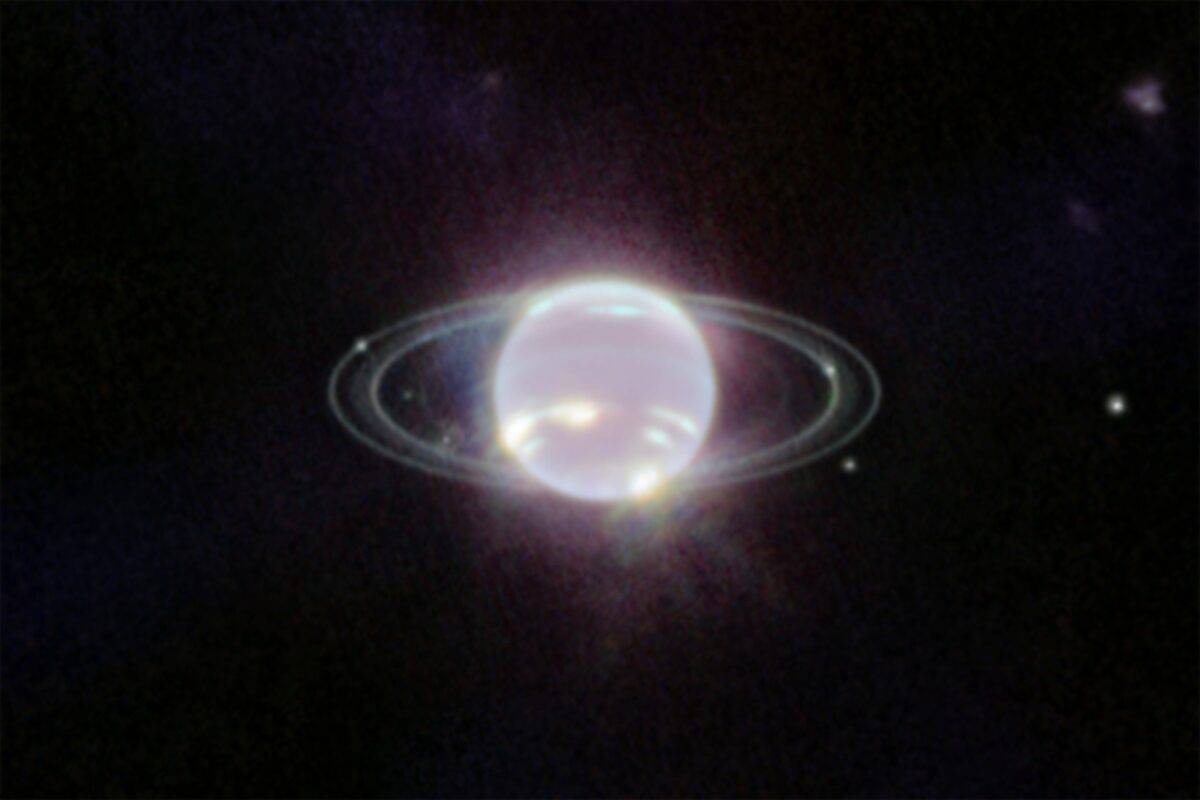
This is a composite JWST image of the planet Neptune prepared by scientists at the University of Arizona. Its high-resolution Near-Infrared Camera (NIRCam) imaging has brought the beautiful rings of this solar system planet into crisp focus. You can also see some southern hemisphere methane-ice clouds and evidence of wind and storm activity.
11. The Tarantula Nebula
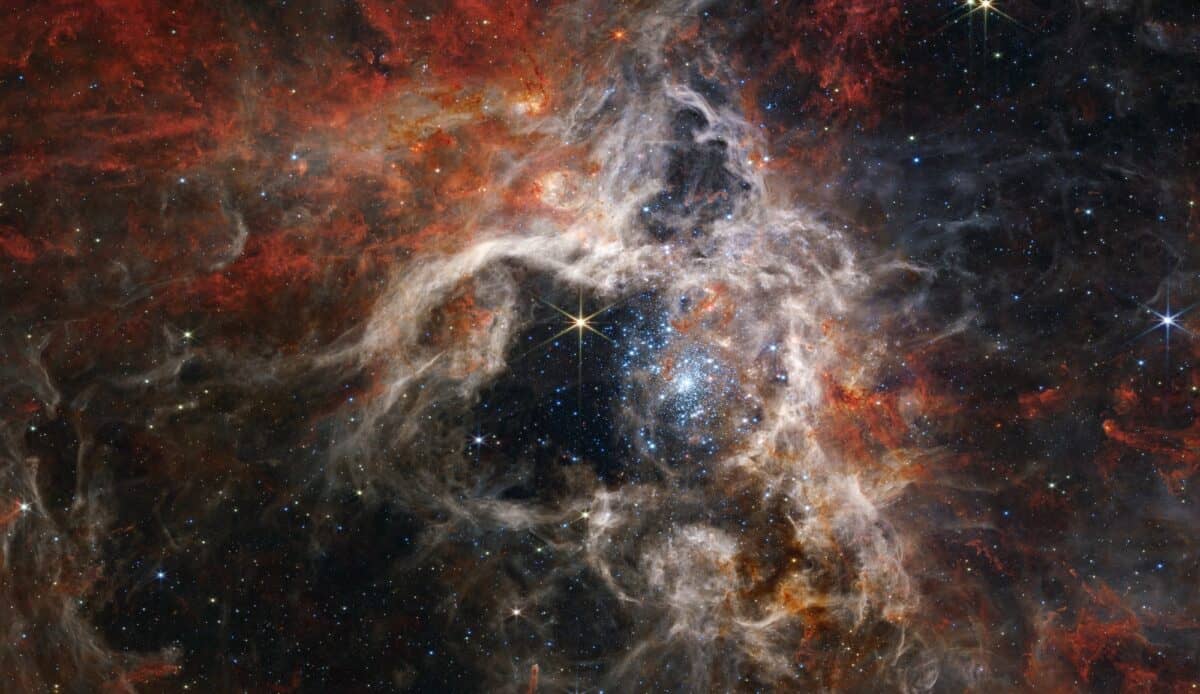
This is a massive image that is over 340 light-years wide showing the tendrils of the star-forming region known as the Tarantula Nebula. The JWST has revealed innumerable young stars that have never been seen before as they emerge from cosmic dust. The resolution of this nebula of the Dorado constellation has been enhanced by the Near-Infrared imaging technology of the JWST.
12. The 30 Doradus
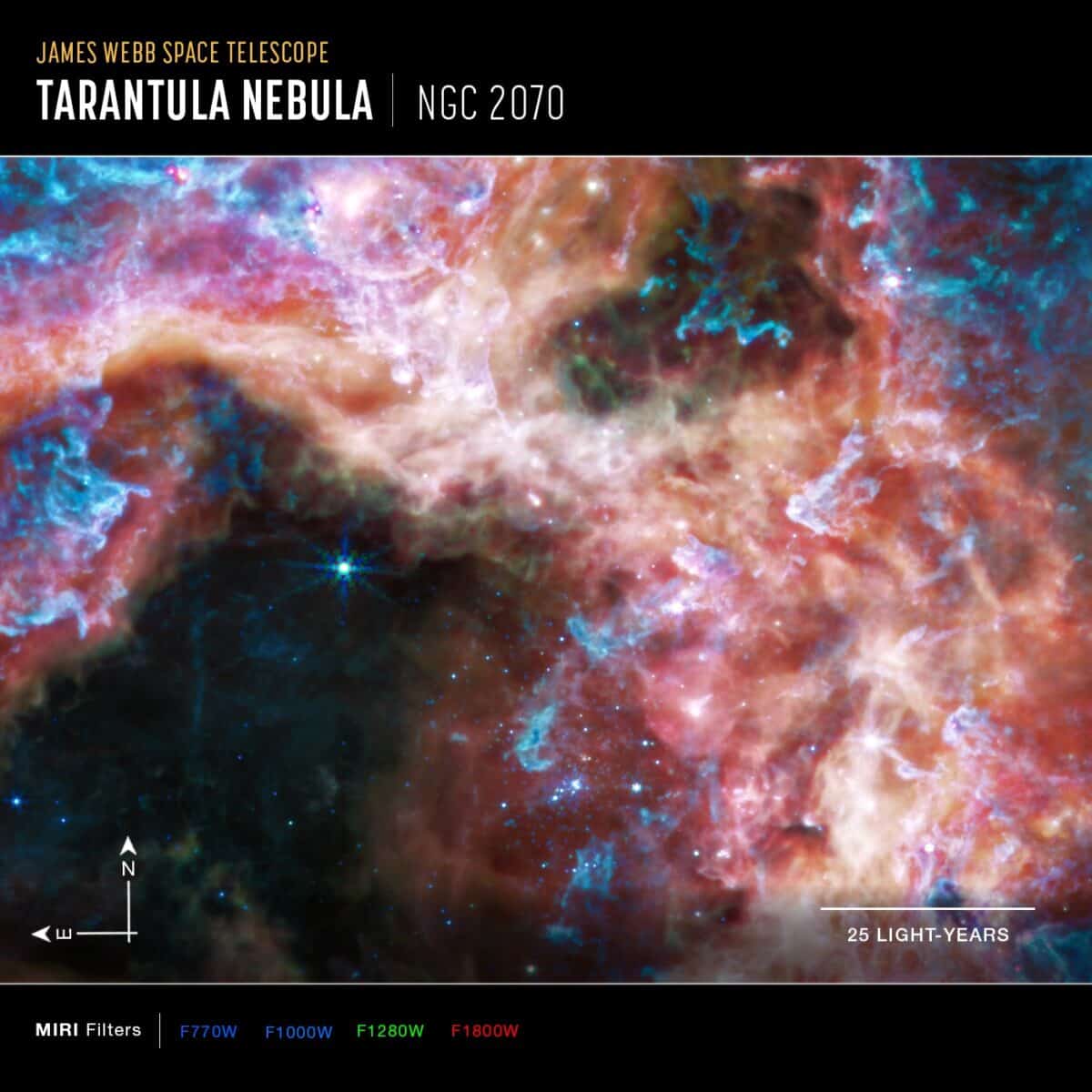
Take a look at this expanded image of the Tarantula Nebula shown as part of the Large Magellanic Cloud (LMC). This famous nebula was first observed by the astronomer Nicolas-Louis de Lacaille in the 18th century. Over 300 years later the JWST is taking a closer look at this nebulous phenomenon.
13. Cosmic Cliffs of the Carina Nebula

This epic conglomeration of stars, dust, and gasses looks like you could hike it! The Cosmic Cliffs is actually a star-forming region of the Carina Nebula that has been captured by the infrared camera of the James Webb Space Telescope. This unique image shows areas of star birth and the edge of a massive gaseous cavity, a high-energy area with hot ionized gasses and dust that are gradually eroding the wall of the nebula.
14. Stephan’s Quintet

This image produced in July 2022 is currently the largest image produced by the James Webb Space Telescope. It is equivalent in size to ⅕ of the diameter of the Moon! Stephan’s Quintet is a collection of 5 galaxies that have been imaged by the JWST’s Webb’s Near-Infrared Camera (NIRCam) and Mid-Infrared Instrument (MIRI).
JWST shows this galaxy group in astonishing detail with newly visualized details like millions of newly born and young stars, swept up in trails of gas and dust. The image has been colorized beautifully by the team at NASA to delineate all these scientifically important features.
15. Comparision Images of the Southern Ring Nebula

These two images of the Southern Ring Nebula show differences in imaging by the Near-Infrared Camera (NIRCam) and Mid-Infrared Instrument (MIRI) of the Webb Telescope. Both images have colorized the infrared energy captured by the invisible telescope.
This vibrant image depicts a white dwarf star, as it ages and emits its energy which is ejected as shells. The color differences are because the two cameras capture different wavelengths of electromagnetic energy.
16. The First Deep-Field Image of the JWST
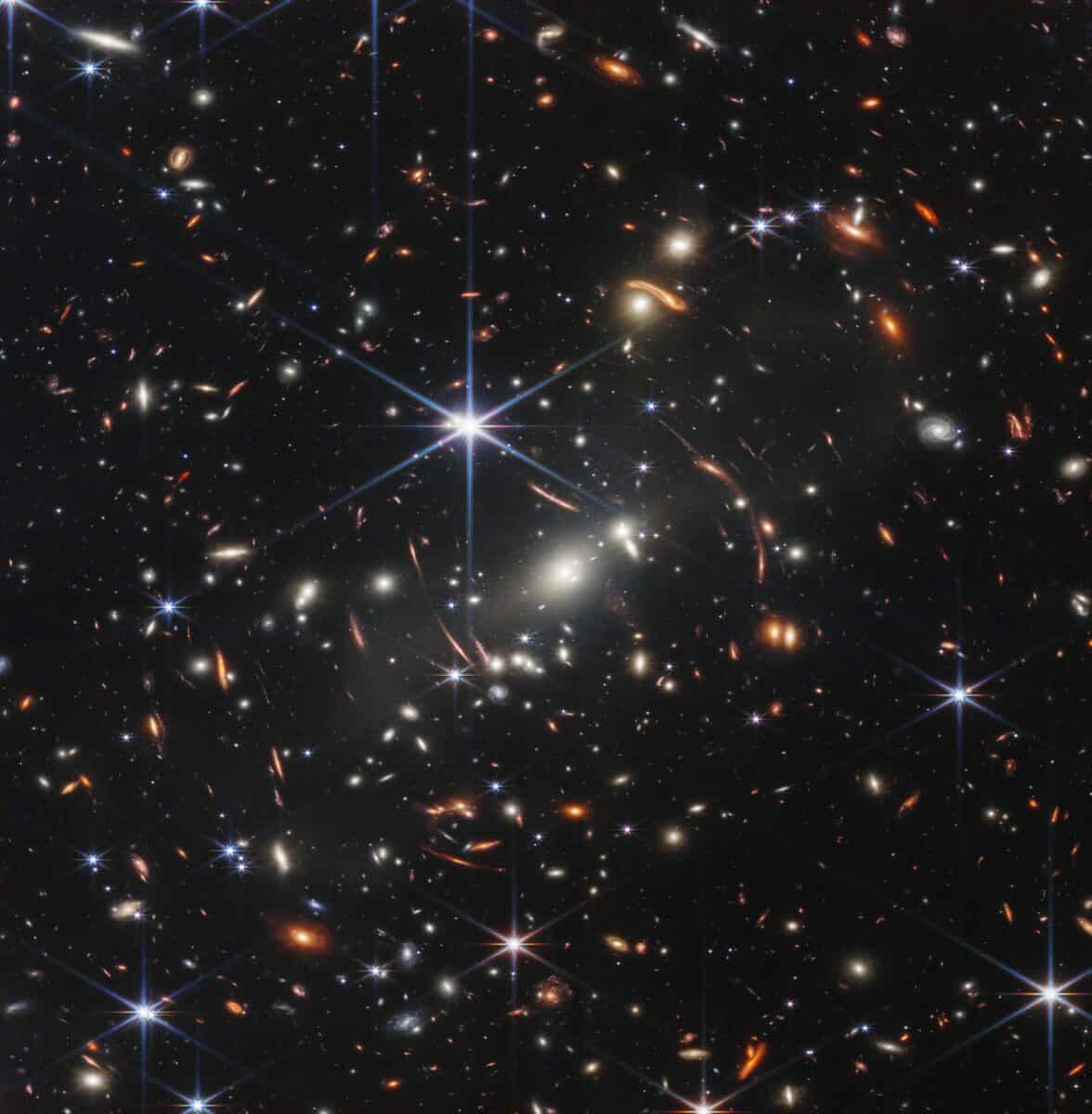
On the 12th of July 2022, the James Webb Space Telescope captured its first deep-field images, looking far into space and imaging thousands of galaxies in infrared. This image has an immense amount of detail, with galaxies and dark matter actually imaging and reflecting the light and energy from other galaxies and constellations, a phenomenon called “mirroring.” These distant and early images are expected to assist astronomers in understanding the early universe.
17. Globular Cluster Messier 92

Messier 92 is a globular cluster, a tightly packed mass of stars that have formed simultaneously. If you can believe it, there are over 300,000 stars in this 100-light-year-wide image. If you were on a planet amidst these stars, it would be daytime continuously, due to the sheer number of stars and their density. Astronomers are currently studying this image to understand the motion and physics of the individual stars in the cluster.
18. Globular Cluster M92

This early 2023 image of the Messier 92 globular cluster has a black stripe down its middle known as a chip gap. It is due to the separation of the two long-wave detectors of the JWST. However, by removing the incredibly dense center of the star cluster, scientists have been able to focus on the less dense edges of the cluster, which have been beautifully delineated by the NIRCam instrument of the JWST.
19. Wolf-Rayet 124
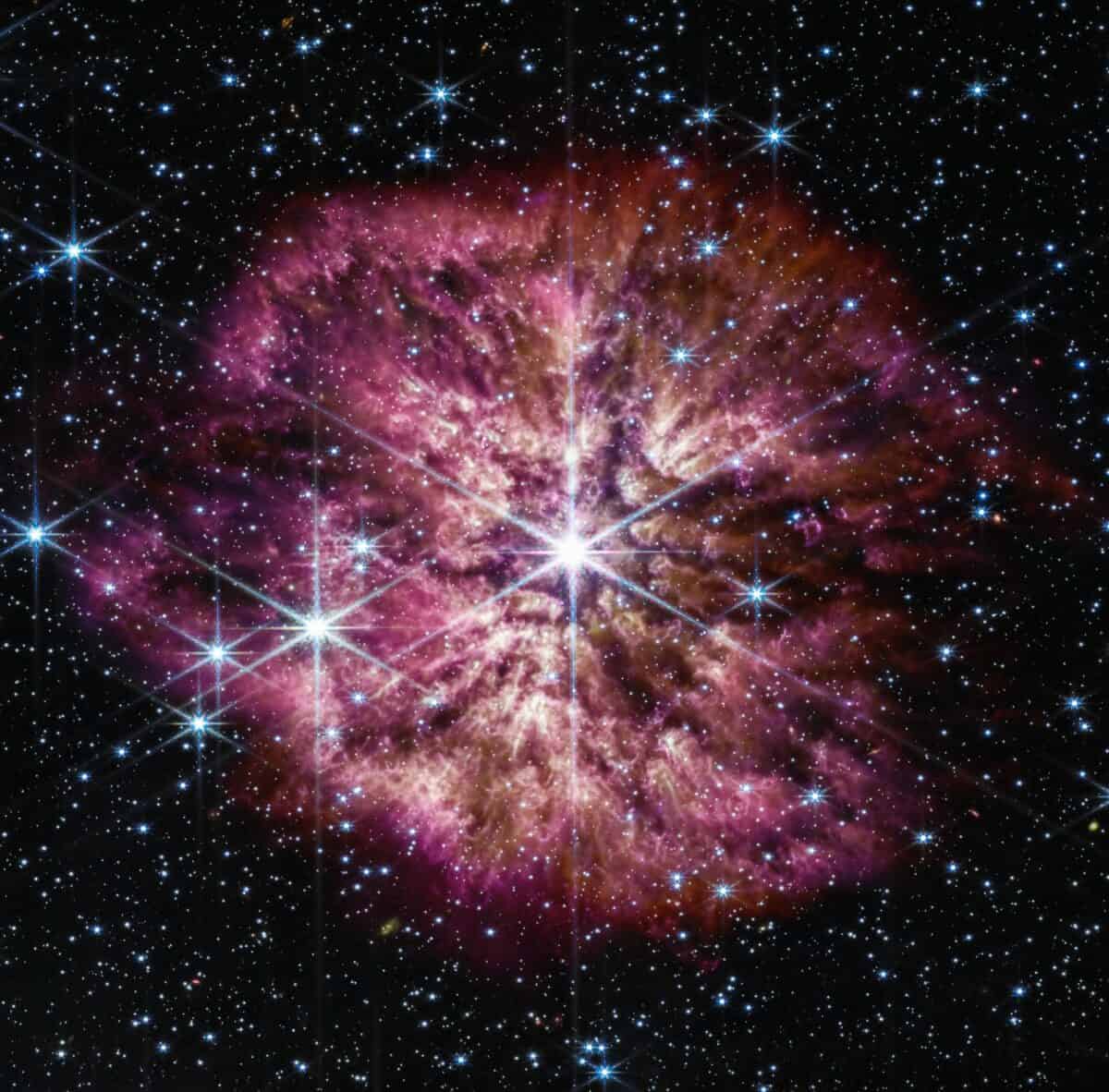
The Wolf-Rayet 124 (WR 124) is the luminous hot star that dominates this compelling JWST image. It has been taken using near and mid-infrared imaging by the JWST. The different wavelengths of energy emitted by this powerful star and nebular are delineated by skilled colorization by astronomers. There are also background stars and galaxies that make this image a stunning one!
20. NGC 1365
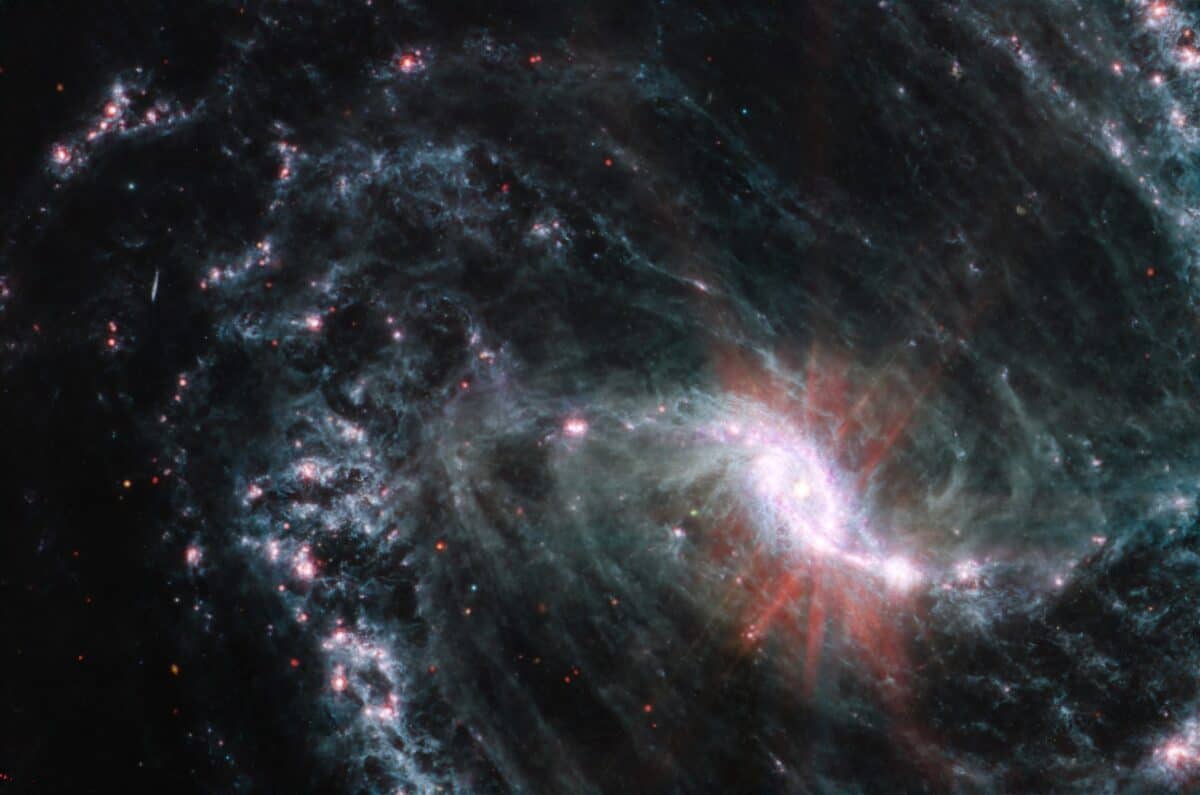
This is one of the ‘first-look’ JWST images of The Great Barred Spiral Galaxy, more than 56 million light years away from Earth. This galaxy, part of the Fornax constellation, is one of the largest known and at least twice the size of the Milky Way. The high resolution of this unique Mid-Infrared Instrument (MIRI) image provides insights into the formation of young stars and galaxies.
The image shows clumps of dust and gas that have formed cavernous areas which have absorbed light from the developing stars and emitted infrared energy that the JWST has picked up. The breathtaking spiral arms of this double-barred galaxy are studded with star clusters.
21. Pandora’s Cluster
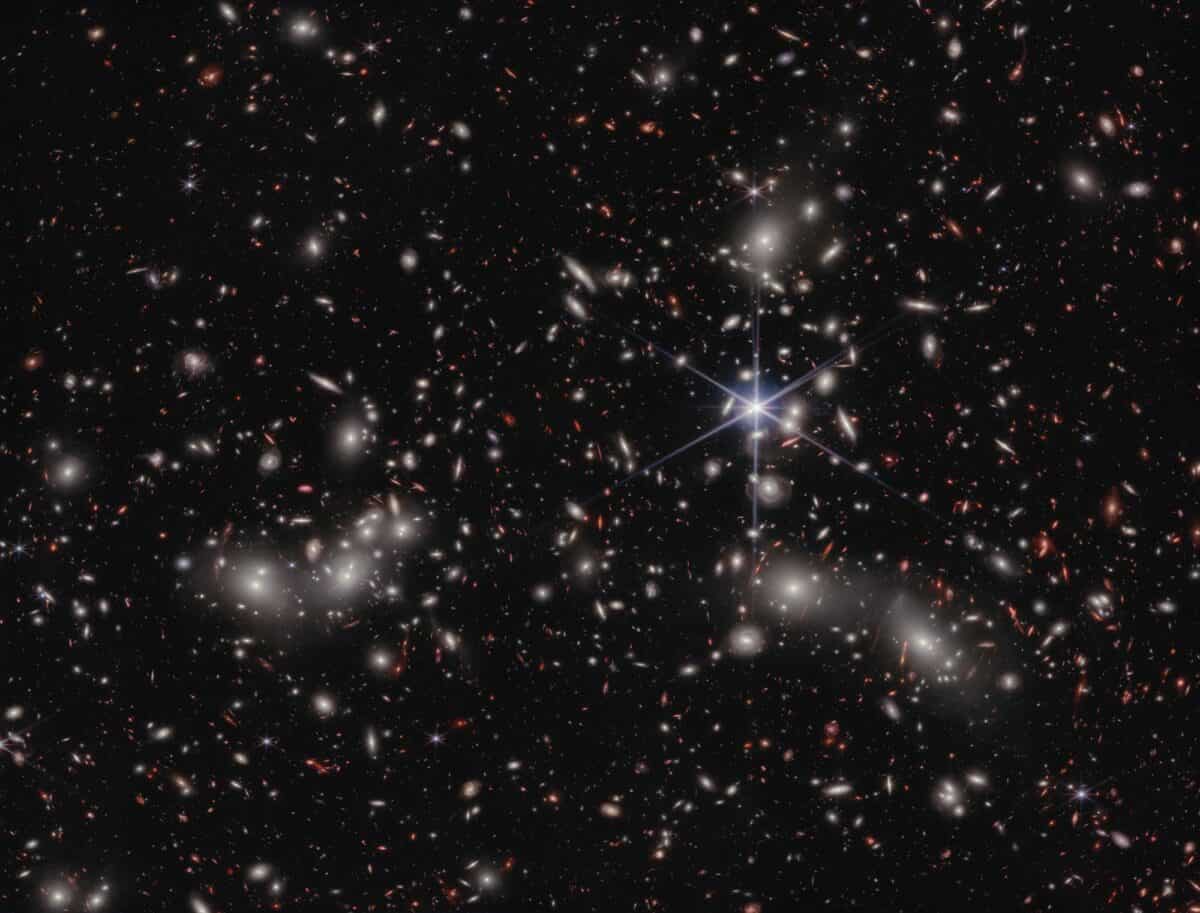
This image should really be viewed with the zoom function on the Webb Space Telescope website because there is so much amazing detail that you cannot see unless you’re up close. This image, captured with the JWST, contains approximately 50,000 sources of near-infrared light. Light has traveled from different distances and sources in this vast image that contains numerous mega-clusters including the famous Pandora’s Cluster.
Most of the light from these galaxies is incredibly old, indicating that the images are of very early galaxies in formation. NASA and ESA scientists are studying these images with NIRSpec data that is being used to measure distances and the material composition of key areas of these galaxies.
22. NGC 1433 (Horologium Constellation)
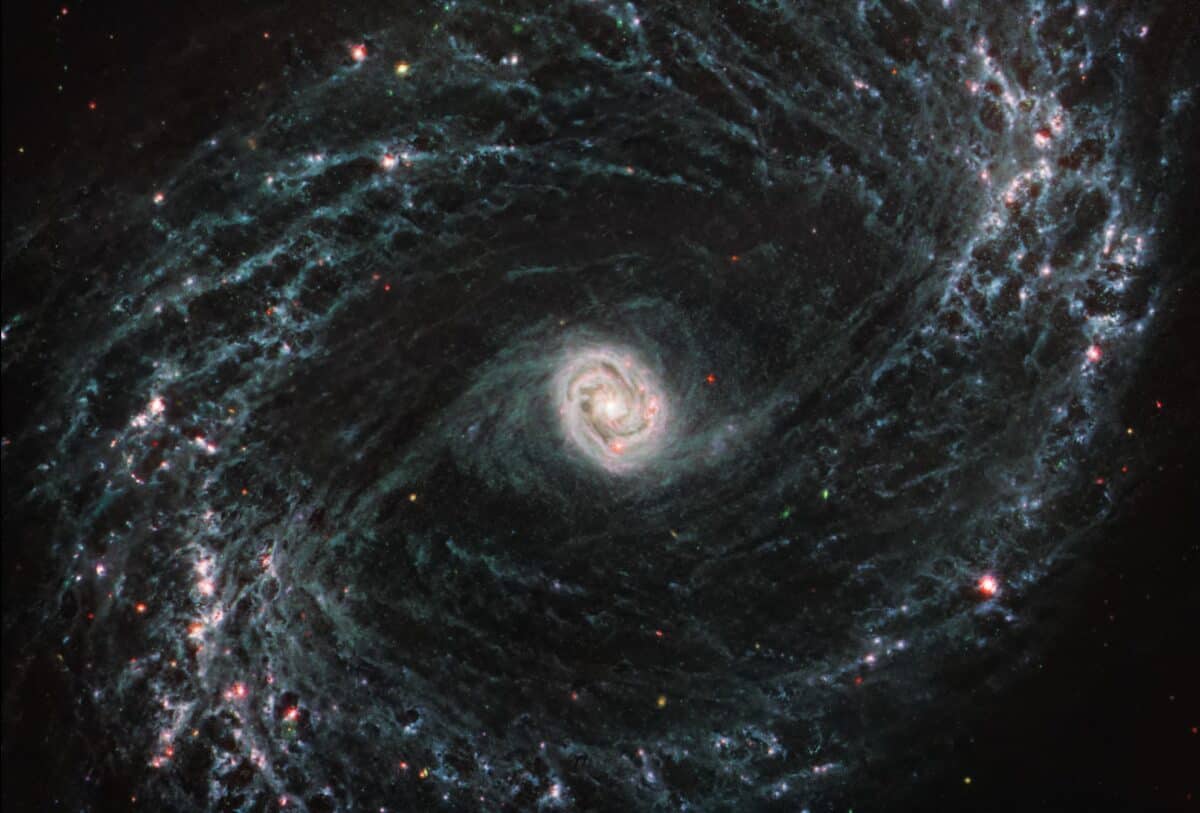
This breathtaking image is of the nearby barred spiral galaxy NGC 1433. This Seyfert galaxy is just one of 19 galaxies of the massive Horologium Constellation. A Seyfert galaxy is a galaxy with an active nucleus, in this case, a supermassive black hole that is pulling in material at a high rate. This observation by the Mid-Infrared Instrument (MIRI) beautifully captures the gorgeous spiral arms that seem to be embracing numerous young stars blowing out hot gasses and dust into an interstellar medium.
Scientists are intrigued by this image because it has displayed a variety of dynamic processes associated with star formation, set against the larger galaxy. This image is also important because of its proximity to earth and indications that it could have collided with another galaxy.
23. NGC 346 of the Tucana Constellation
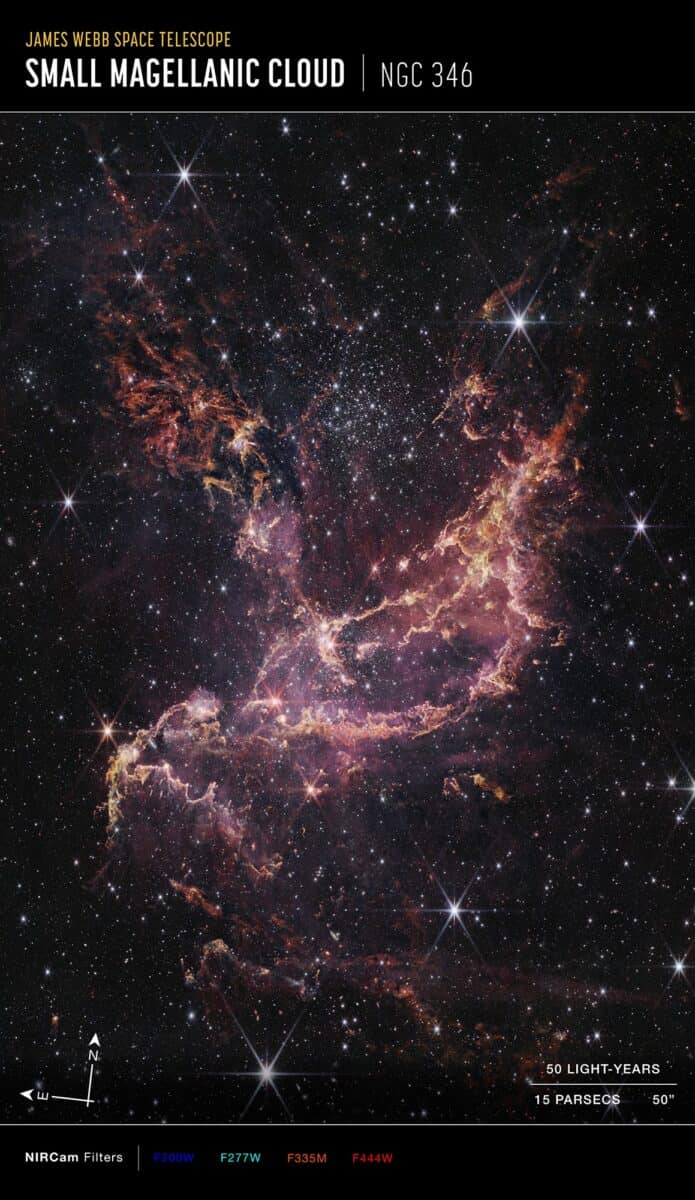
The JWST’s Near-Infrared Camera (NIRCam) has taken this image of NGC 346, a nearby star cluster with nebulosity. This June 2022 image is a composite image that has been colorized with relative visible-light color. The image is about 3.9 arcminutes, or 240 light-years, across.
24. AU Mic
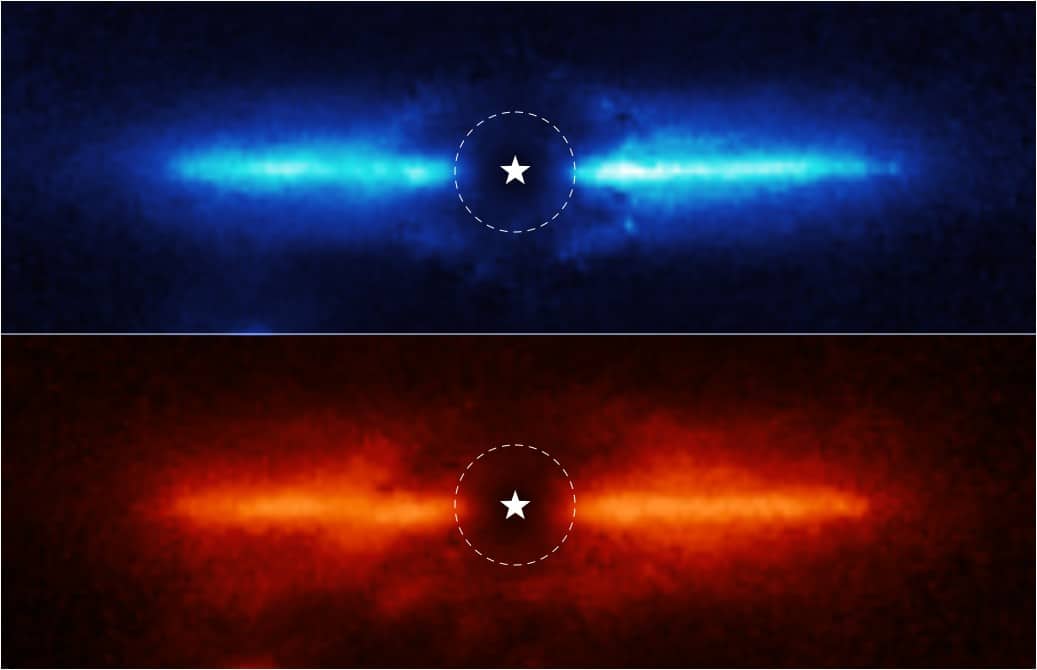
Wow! These striking images are of a dust and debris disc around a red dwarf star called AU Mic. It is more than 32 light years away and part of the Microscopium Constellation. Rather than imaging the intense light of the star, astronomers used the JWST’s coronagraph to block it out. This allowed them to focus on the surprisingly bright and detailed disc which displays varying types and levels of brightness according to the infrared wavelengths it is emitting.
25. Southern Ring Nebula Star Interactions
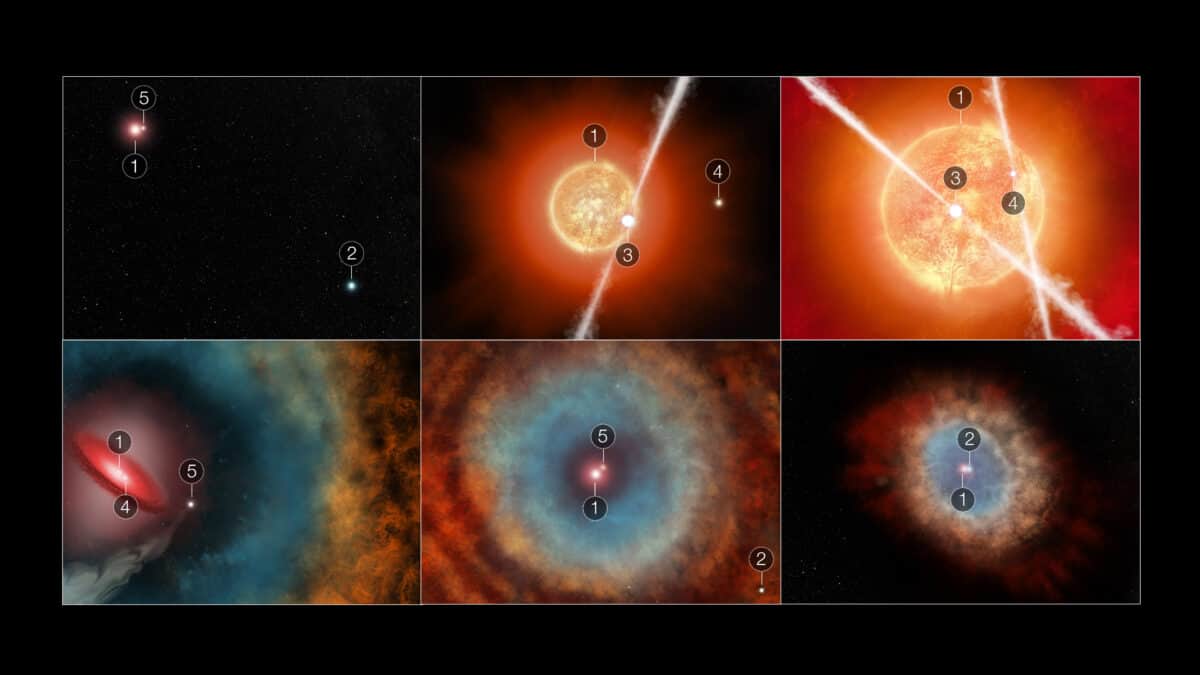
These illustrations are based on images taken by the James Webb Space Telescope. They outline the formation of the Southern Ring Nebula with interactions between the 5 constituent stars. Scientists think that an aging star in a nebula enveloped a much younger star, releasing debris and material that interacted with the other stars in the group. This is purely imaginative speculation, but the Webb telescope image from December 2022 has provided a useful starting point.
26. MACS0647 of the Camelopardalis Constellation
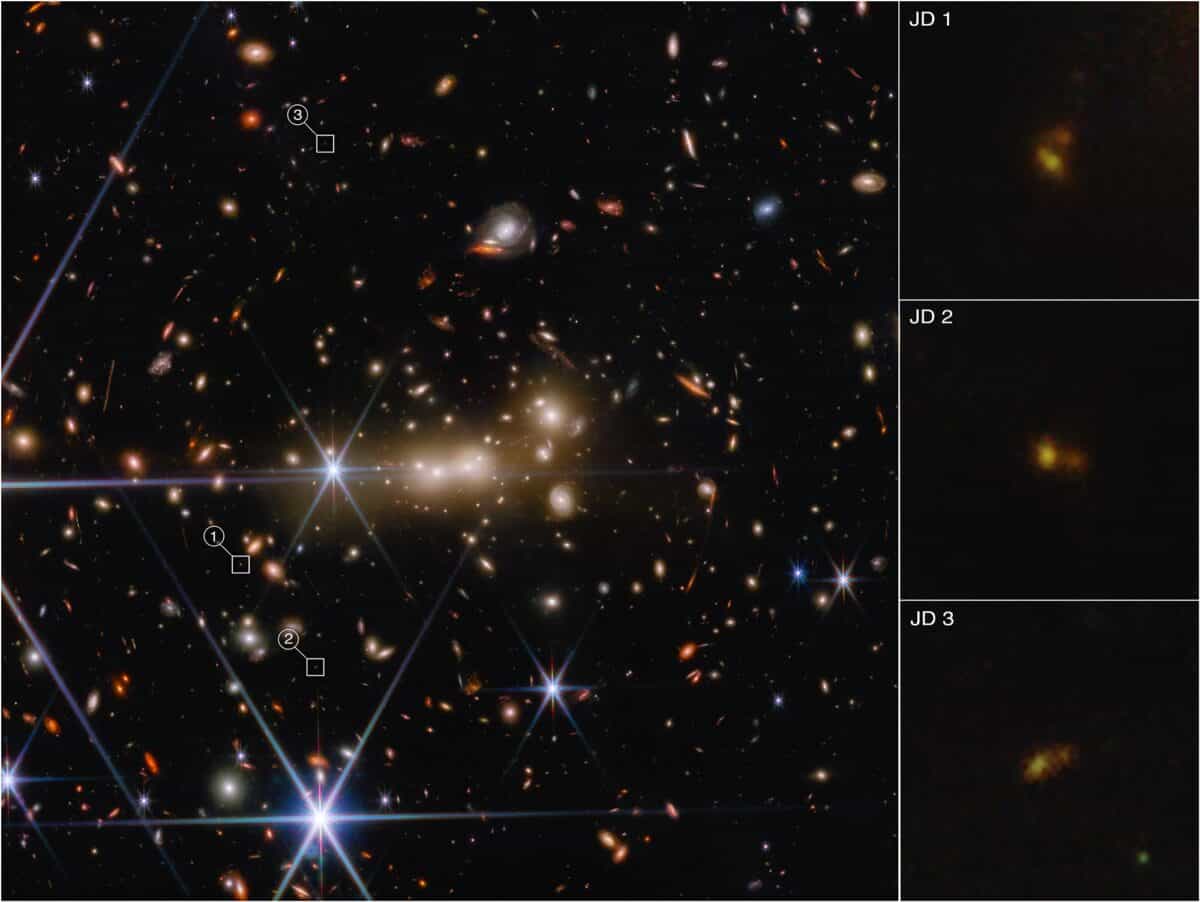
This galaxy cluster, imaged by the Near Infrared Camera (NIRCam) of the JWST is thought to be a cosmic lens. The cosmic lens phenomenon is due to the massive gravitational force of the cluster that begins to warp the space around it, brightening and magnifying light from more distant objects. In this instance, MACS0647 bends and magnifies the light from the MACS0647-JD system.
27. The Wolf-Rayet 140 Star
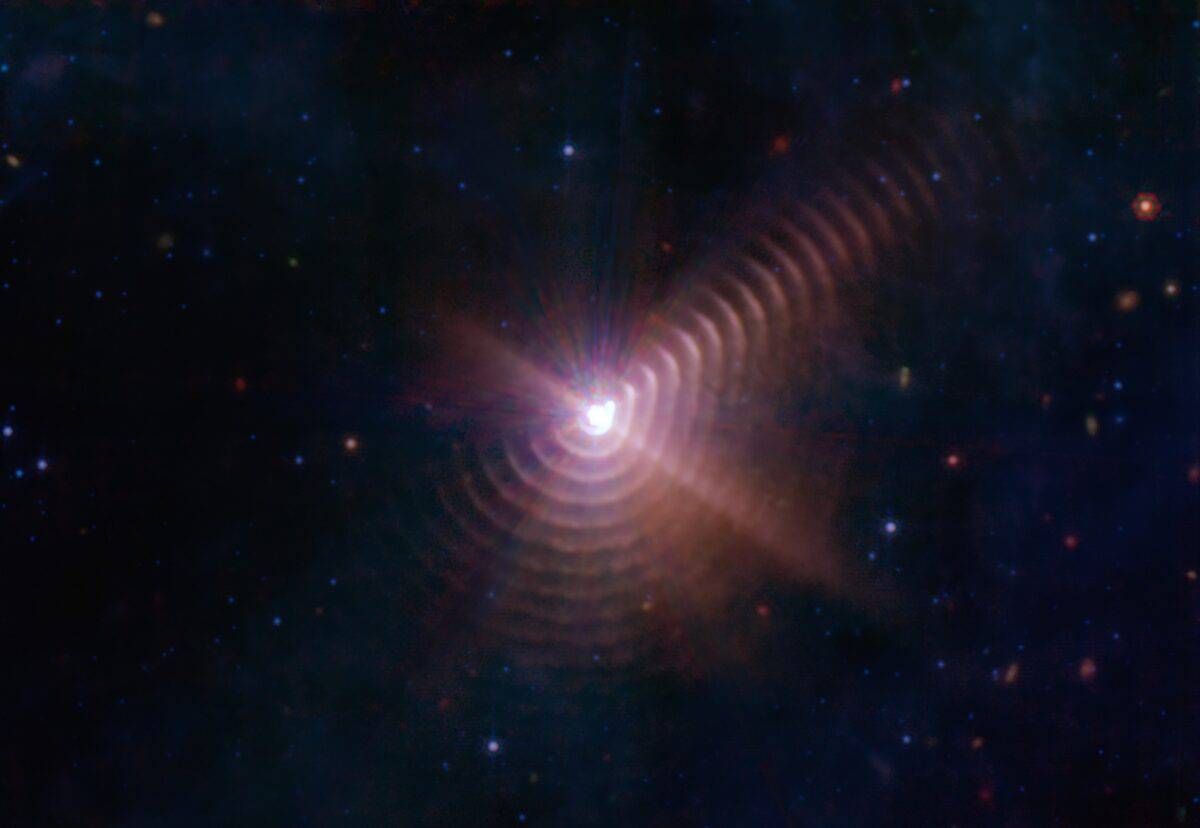
This is another image of the Wolf-Rayet star with gorgeous rings. The rings were created by shells of cosmic dust and look like tree rings. This distinctive display appears once every eight years during the orbit cycle of the star, created when binary stars make their closest approach to each other.
28. Titan, a Moon of Saturn
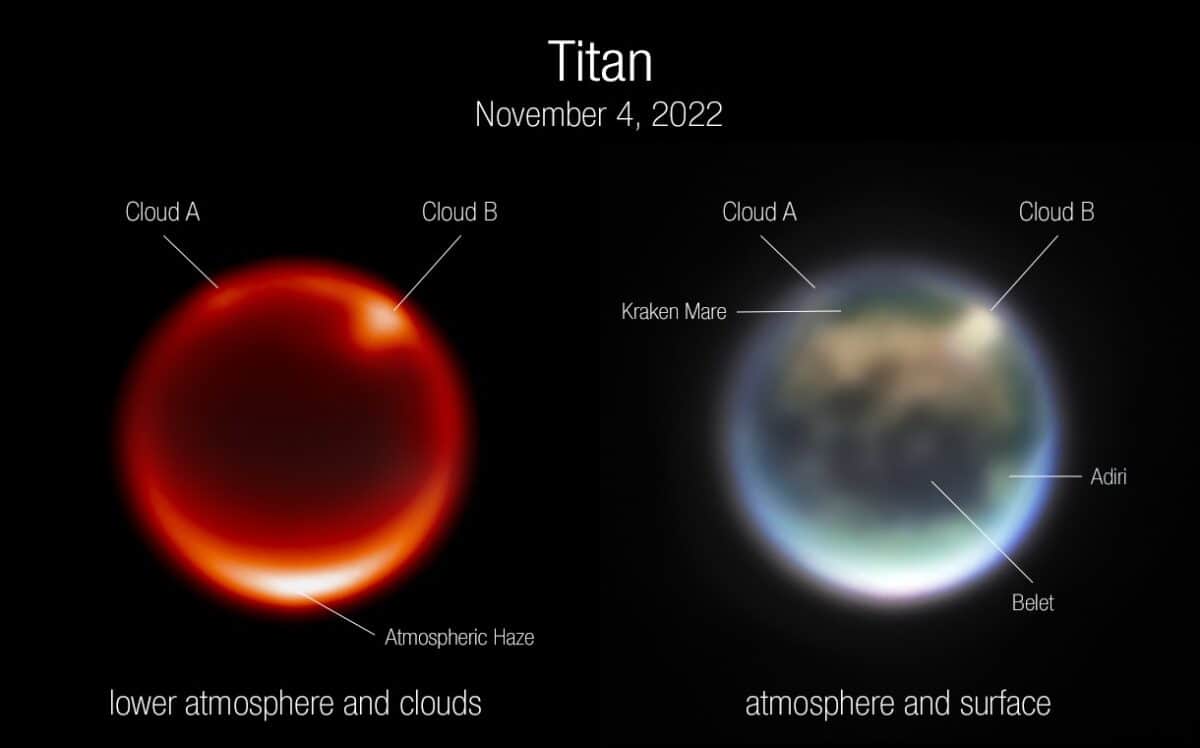
This is a Webb telescope image of Titan, one of Saturn’s 83 moons! These composite images, compiled from images using a range of NIRCam filters, bring out details of the lower atmosphere of this moon including clouds, the methane sea, and sand dunes.
29. Pillars of Creation
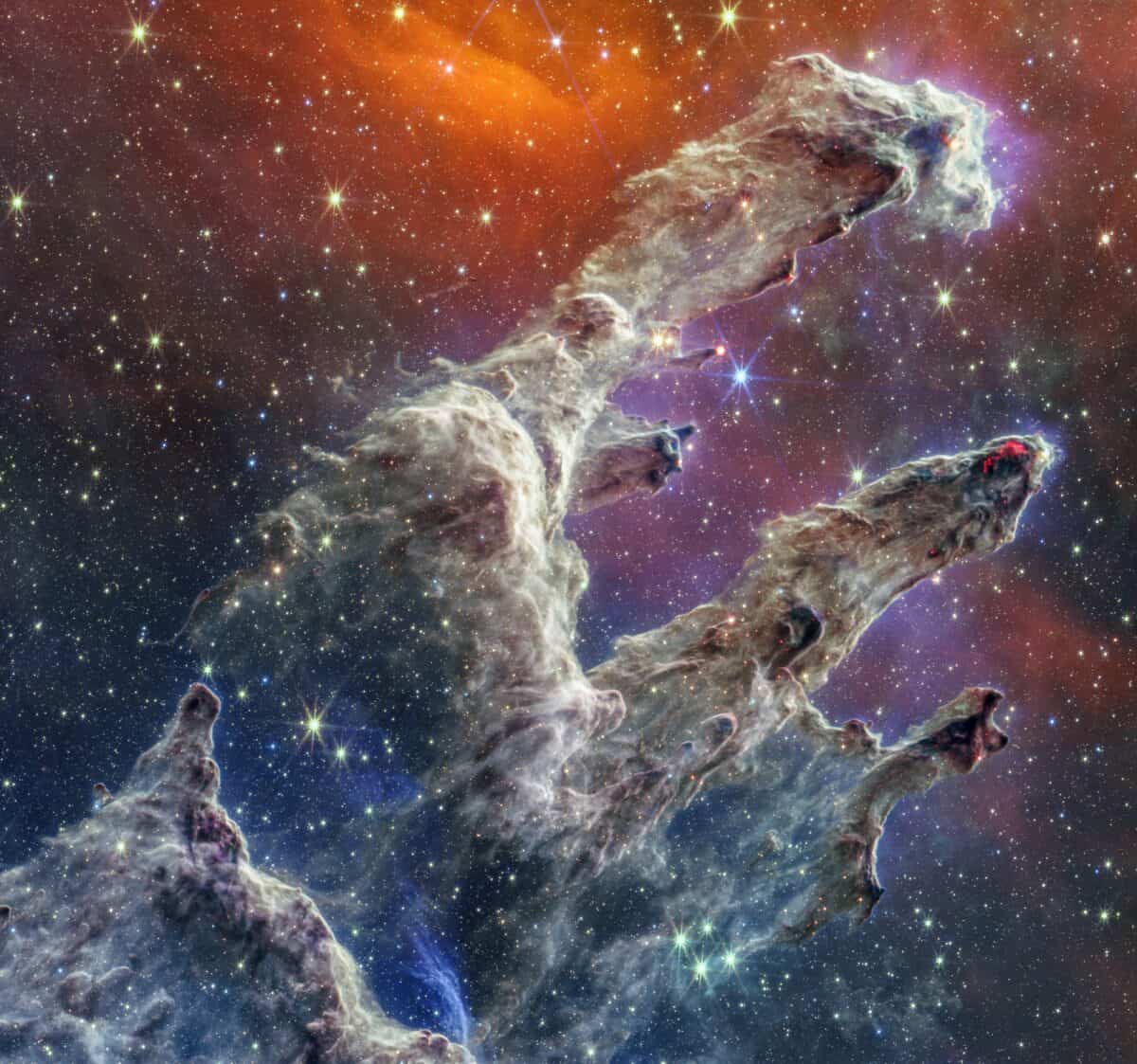
This famous photo was made by combining images from two cameras on the JWST. The near-infrared image was combined with the mid-infrared image to create the iconic image of the Pillars of Creation. The pillars were created by dust, which is a major ingredient in the formation of stars. These dense clouds of dust are one reason why this region is teeming with stars. The Pillars of Creation is located in the Eagle Nebula, approximately 6,500 light-years away from Earth.
30. Wide Field Image of Neptune

This is a stunning wide-field image that includes the planet Neptune set against a background of hundreds of varied galaxies. Neptune is a much bigger celestial body than Earth, but in this image, it appears small when set against the backdrop of outer space.
Rounding Up
These gorgeous James Webb Telescope images are only possible because of the remarkable capabilities of the James Webb Space Telescope, the biggest space telescope that has ever been launched. The world eagerly awaits further breathtaking images and scientific discoveries from the JWST’s journeys into deep space.
Want to Retire Early? Start Here (Sponsor)
Want retirement to come a few years earlier than you’d planned? Or are you ready to retire now, but want an extra set of eyes on your finances?
Now you can speak with up to 3 financial experts in your area for FREE. By simply clicking here you can begin to match with financial professionals who can help you build your plan to retire early. And the best part? The first conversation with them is free.
Click here to match with up to 3 financial pros who would be excited to help you make financial decisions.
The image featured at the top of this post is ©NASA, ESA, CSA, STScI, Joseph DePasquale (STScI), Alyssa Pagan (STScI), Anton M. Koekemoer (STScI) .
